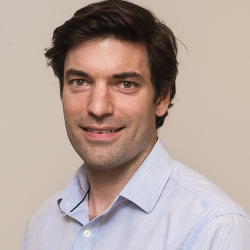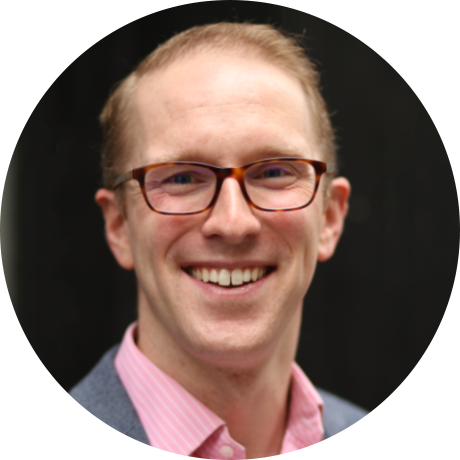Connecting the dots to ensure community prosperity and economic competitiveness: A conversation with Federation of American Scientists CEO Dan Correa.
Infrastructure — physical, digital, and social — is a necessary foundation for scientific discovery. At the same time, science is a necessary guide for sustainable and equitable infrastructure. A virtuous cycle of broad experimentation, thoughtful execution, and smart investment connects these dots to power American innovation and economic competitiveness.
Of course, scientific discovery is often built on productive failure — experimenting and learning until the answer is clear — but infrastructure projects can’t afford to fail. Instead of “moving fast and breaking things,” infrastructure for science and science for infrastructure must move thoughtfully and justly to fix what’s broken and build toward equity.
Those working at the intersection of science and infrastructure have a growing awareness that what has worked in the past won’t necessarily solve the problems of the present, let alone the future. Addressing systemic and endemic challenges will require fresh thinking and transformative ideas — with people and processes aligned to bring those ideas to life.
The United States is at a pivotal moment, with landmark legislation paving the way for significant investments in infrastructure. Luminary Labs has been working with a community of practice developed by National League of Cites, America Achieves, Drexel University, and the Federation of American Scientists to support the Economic Development Administration’s Build Back Better Regional Challenge finalists — 60 coalitions driving regional innovation and transformative, inclusive growth. As FAS CEO Dan Correa says, infrastructure is “the scaffolding for progress.” I recently spoke with Dan about the potential for prosperity in the places where science and infrastructure overlap.
The Federation of American Scientists has an interesting origin story and has been working for decades to make the world more secure. How is that history showing up now, and what are your biggest present-day priorities?
The Federation of American Scientists was founded 76 years ago by scientists who were a part of the Manhattan Project. This was a time when the idea of a public interest organization was not commonplace — but they realized, at the dawn of the nuclear age, that the associated policy and technical questions were too important for scientists to be on the sidelines. And so the mission and the throughline has been bringing technical expertise to bear on the most pressing challenges of the day.
Today, we reflect that mission. We continue to be an indispensable source of technical expertise on questions related to nonproliferation and other significant existential threats to society. But we also are pursuing that initial vision in new ways by looking at a longer list of deeply important societal challenges — everything from climate and access to opportunity to high-skilled immigration and economic competitiveness. We bring technical expertise and policy ideas to the table, driving change and impact.
Do you feel science is still on the sidelines today?
The world certainly looks different. We have an entire federal research enterprise that has expanded and matured in the decades following World War II. It is now appropriate to reexamine our footprints, and update and renew institutions. That is an exercise we’re participating in and that we’re really excited about.
But the core thrust of seeking to put technical expertise, science technologists, and technical expertise into the policy conversation remains in too many domains. It’s more the exception than the norm. Education is one example: The Department of Education has a vanishingly small budget for transformative research and development, and the tools at their disposal are limited. There are lots of other examples where the stakes are really high in domains that we don’t traditionally think of as being scientific or having a tech component. But the reality is that these tools have massive, massive power. And that’s the case with education — there’s an opportunity for significant new insights and new tools that could transform our educational system, with really dramatic benefit for our society and for economic competitiveness.
There are lots of other examples — with respect to scientific communication, misinformation on climate, and other topics — where we’re seeing a need to bring facts and evidence into a broadly shared context.
I’m glad that you brought up education — it speaks to the expanding definition and perception of what counts as “infrastructure.” As someone who leads an organization founded and grounded in science, how are you approaching the many intersections with infrastructure?
We’ve seen landmark legislation in the last year on the bipartisan infrastructure framework that not only includes some important new priorities, but also anticipates a growing role for science and technology. There’s a lot that the federal government has taken on. And I see that as both an invitation for our community to contribute as well as a recognition that just doing more of what we’ve done in the past will not address many of the systemic and endemic problems that we face — whether it’s climate-related, whether it’s access to opportunity and inclusion, and more. There’s an opportunity for new resources, new approaches, and new tools that differ from the past.
It’s a really great starting point. This legislation authorized a DARPA for infrastructure to be placed within the Department of Transportation. At the Department of Defense, DARPA brought us the stealth fighter jet and the internet … and using that playbook for high-impact, new ideas that we can’t even imagine yet represents a milestone within the context of infrastructure. So that makes me optimistic.
I think we are at the beginning of an era of great experimentation, and this is truly an exciting time. The philanthropic community has pushed the boundaries of new approaches with respect to demand pull mechanisms like incentive prizes or new organizational models for laboratories. And at the federal level, we’re seeing agencies catching up.
The promise of experimenting with new approaches is that they can unlock dramatic progress on everything from Alzheimer’s and aging to cancer research and how we create a climate-resilient transportation system. This is a significant inflection point in how we think about infrastructure as an R&D community. At the Federation of American Scientists, we view ourselves as policy entrepreneurs, and our vision is to help shape that future.
I really want to pick up on this era of experimentation. It makes me think of some work Luminary Labs has been doing with FAS in support of the Build Back Better Regional Challenge. As part of that, we’re seeing experimentation at state and local levels that invites regions and communities across the country to pursue locally driven projects. I’m curious what has stood out to you? What types of grassroots efforts could inform the way we do things in the future?
Rather than providing resources to communities in a prescriptive way for specific projects that fall within a given list — which is often how government works — EDA’s Build Back Better Regional Challenge invites communities to develop their own vision, hone it, and propose it in a way that promises to diversify the future of economic competitiveness in this country.
My belief is that we are fundamentally a collection of regional economies, and over the last generation, we have seen significant regional diversions. The government — and the federal government, in particular — can help a broader set of regions join in the vanguard of 21st-century economic competitiveness. And that only works when it’s rooted in local strengths and local vision and includes, importantly, a key collection of stakeholders at the table. That includes universities, local nonprofits, force entities, and obviously industry.
Essentially, what the EDA has done has been to offer a pot of money, asking these regions to step forward and compete and craft their own visions. And the things we’re seeing are the best of American ingenuity. The specific clusters are forward-looking and exciting — you can find them all on the EDA website — and the components that these applicants are assembling and the stakeholders they have at the table represent a tremendous amount of really thoughtful strategy. It makes me more confident in the future economic viability of a lot of regions across this country. And it also suggests to me that as a country, we should be doing more of this in terms of competitions and funding to support these kinds of visions. It would help fight some of the divergence I described.
Regional economies are taking an entrepreneurial approach to their own equitable economic development. Another one of your efforts, the Day One Project, has been a shining example of applying entrepreneurial approaches to science and technology policy. (One of my Luminary Labs colleagues, Alex Leader, developed a policy idea through the Day One Project.) Can you talk a little bit about policy entrepreneurship and what you’ve learned from the past couple years of the Day One Project?
We launched the Day One Project as an initiative within the Federation of American Scientists, and the concept was rooted in the experience that many of us — myself included — had in government. I served for four years in the Office of Science and Technology Policy at the White House. And the lived experience of a policymaker in government is that everything moves really quickly and you need lots and lots of help.
So we launched the Day One Project before the 2020 election on the basis of three hypotheses. The first is that designing policy ideas to meet a moment — in this case, a potential transition — is a really powerful way to accelerate them. Packaging ideas for a specific policy window is high-impact.
The second was that in government, the best ideas don’t just come from other people, but unexpected places. We built the Day One Project as a platform for sourcing ideas rather than as a think tank for our own ideas. We tapped into the latent energy across the science and technology community — broadly defined as folks in industry, nonprofits, academia — who were excited to be able to step forward and contribute their best ideas and work with us to hone them, with the help of veteran policymakers.
Then the third piece was to develop, refine, and package ideas in a way that a policymaker would actually understand and be able to act on. We work with contributors to write up short memos that are long on implementation specifics and answers to frequently asked questions. The idea for policy change is just a starting point, but someone in government ultimately needs to think through how to actually do it — whether it’s legislation, regulation, procurement, or any of the other myriad tools.
The Day One Project hypothesized that if we did those three things, we could have a deep impact. At first, we weren’t sure if anybody would even respond to be a part of this volunteer army. But ultimately, we found overwhelming interest from across the community. We’ve now had several hundred contributors step forward and work with us on ideas. We’ve created something of a new model for how policy development can happen at scale.
The core of what we’ve learned is that this is not just a platform for policy development but that this work and this agenda are animated by policy entrepreneurship. We are excited by all the traction that many of these ideas have gotten, and we can point to lots of examples of actual implementation. But we’ve also been deeply excited to see more of our community get into the practice of developing and shaping ideas, then pitching those ideas and engaging with policymakers. That is how we actually build a community of science and tech policy entrepreneurs who are positioned not only to write up their ideas but to implement them in government. That’s what this community really needs — for people to find their voice and find their inner policy entrepreneur.
In this high-potential moment, what’s still missing from the conversation? What do you wish people were talking about more?
We need to continue to do more to engage in reflection on ways that we can advance equity and inclusion through our work. I think that is both who we invite into the community and who we champion. But it’s also the ideas that we are advancing through platforms like the Day One Project. We need to do a better job of making that a central priority of all of these proposals.
If I think about what the frontiers of opportunity are and places where we should really be digging, there’s a whole range of different tools that we should be using in order to foster the next generation of tools and innovations and emerging technologies. That’s one area. Secondly, and probably the number one thing we could be doing in this science and technology space, is high-skilled immigration — inviting and advancing more people. The community of high-skilled immigrants has outsized impact as entrepreneurs, researchers, and contributors in their communities. There’s a pretty significant risk to turning off that spigot.
And to return to this question of infrastructure and models for science, we still need to build out an evidence base for what works well. We’re in a moment of experimentation, and it’s incumbent on us to not only embrace it, but also do the hard evaluation work to figure out what works to boost the return on investment of our research investments. That’s just a starting list.
If we’re bringing all kinds of people and disciplines together, what’s your dream project or a dream initiative — and what kinds of partners do you want to bring with you?
The real secret of our work is that we’re just staffers. When we talk about a policymaker as a customer in our policy entrepreneurship work, we don’t have in mind someone like the Vice President of the United States. We have in mind someone whose name will never be public, somebody who is the agent of change within a really important public entity or federal agency. Those people are American heroes.
We need more visionary, highly skilled, highly effective public-sector entrepreneurs. Which is not to say that we do not have lots of really, really talented people in the federal government. But there is an opportunity to invest in helping that community continue to upskill. That’s something that I’m passionate about. Whether it’s incentive prizes, human-centered design and design thinking, novel mechanisms for procurement that can get you better results by buying what works, or starting entirely new institutions like new advanced research project agencies — people have to staff those for them to be real.
Our policy agenda is fundamentally about implementation and implementation is fundamentally about people — helping to invest in people and build out that vision for the future is where the action is.



